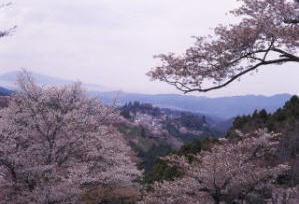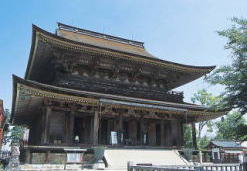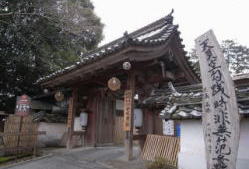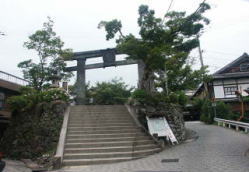TOP > Welcome to Rekishikaido > Yoshino
Thema area Yoshino
 Yoshino is in the northern reaches of Yoshino-gun, in the central interior of Nara Prefecture. The town is crossed down the middle by the east-west flowing Yoshino River. Within the town limits are found the Yoshino-Kumano National Park and Yoshinogawa Tsufuro Nature Park, while the cherry blossoms of Mt. Yoshino are known throughout Japan.
Yoshino is in the northern reaches of Yoshino-gun, in the central interior of Nara Prefecture. The town is crossed down the middle by the east-west flowing Yoshino River. Within the town limits are found the Yoshino-Kumano National Park and Yoshinogawa Tsufuro Nature Park, while the cherry blossoms of Mt. Yoshino are known throughout Japan.
Blessed with pristine mountain torrents, Yoshino was settled long ago because of its strategic location along ancient byways between Kishu, Ise, Kyoto, Nara and Kumano.
Since long ago, the area has been recognized and revered as a holy land for mountain worship, but come the Nara Period, En no Gyoja built facilities for attaining enlightenment via a mountain-dwelling lifestyle and ascetic practices in the Kinpu Mountain Range that stretches from Yoshino to Omine. From that point through the middle ages, Yoshino thrived as Japan’s largest mecca of Shugendo or mountain asceticism unique to Japan.
Today, the area is registered as a World Heritage under the acclaimed title of Sacred Sites and Pilgrimage Routes in the Kii Mountain Range.
Point
Yoshino is located south of Asuka. It takes 75 min. to go there from Osaka by Kintetsu special express. It's possible to go and return in a day, but we recommend you to stay one day. Yoshino is famous for its cherry blossoms. The origin of watching cherry blossoms is Enno Ozuno. He carved a statue of Buddha on a cherry tree about 1300 years ago. Then the tree became a holy tree. People who visit the temple started to bring trees and plant them.
Please visit Yoshino not only in spring, but also in other seasons.

|
Zao-do of Kinpusen-ji Temple
Since long ago, the Kinpu Mountain Range that stretches from Mt. Yoshino to Mt. Sanjo has been known as a holy land and visited by many of the Japan's nobility. This is where En no Gyoja, the founder of Shugendo, a religious mix unique to Japan that incorporates Buddhist and other spiritual teachings into the mountain worship of early Japan, developed a mountain-dwelling lifestyle and disciplinary practices.
Since that time, many disciplinants have exceeded the bounds of their own personal religions and come to Kinpusen-ji Temple to practice asceticism at the primal dojo of Shugendo.
Inside Zao-do Temple of Kinpusen-ji Temple, which, at a height of 34 m has come to symbolize Mt. Yoshino, are enshrined the three Zao deities. The temple is made entirely of wood and is second only to the Daibutsu-den of Todai-ji Temple in Nara in size.
How to get there: Take the ropeway from Kintetsu Yoshino Station (Yoshino Line).
Open: 8:00am - 4:30pm
Admission fee: 400yen
Katte-jinja Shrine
Legend tells that angels appeared and danced before Mt. Sodefuri behind the shrine when Prince Oama played the koto in front of the shrine. The shrine's pavilion was rebuilt in 1776.

|
Yoshimizu-jinja Shrine
The shrine was originally a Buddhist temple known as Kissui-in and associated with Kinpusen-ji Temple, but it was transformed into a shrine in the Meiji Period when the government ordered the separation of Buddhist temples and Shinto shrines.
Open: 9:00am - 5:00pm
Admission fee: 400yen

|
Kane-no-torii Shinto Arch
Though old as it is, this Shinto arch was rebuilt in the Muromachi Period (14th century) after the original had been burned down by war in 1348.
Officially, it is known as Hosshin-mon Gate and is the first of four gates that lead to Mt. Sanjo.










